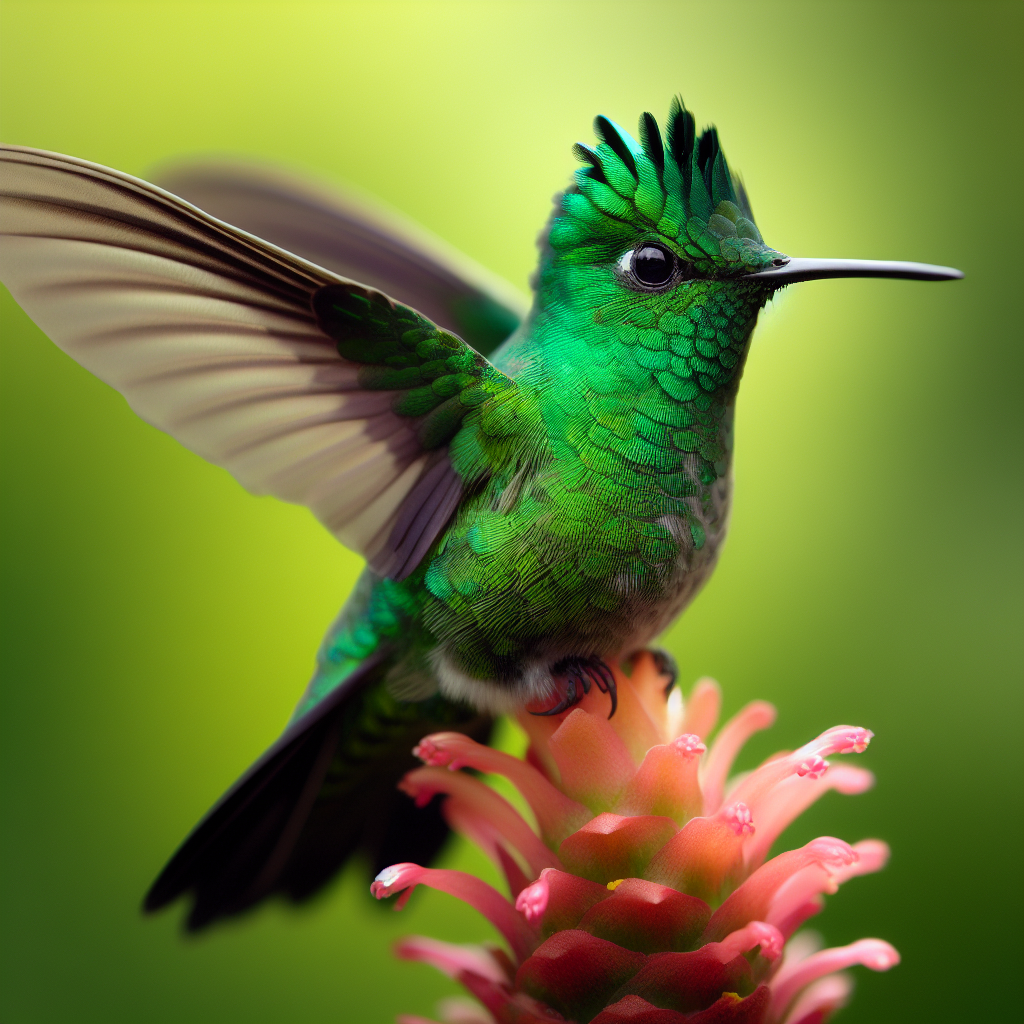Most beautiful small birds - Sykalo Eugen 2024
Green Thorntail Hummingbird (Discosura conversii)
Identification:
- Species name: Green Thorntail Hummingbird
- Scientific name: Discosura conversii
- Family: Trochilidae (Hummingbirds)
- Order: Apodiformes (Hummingbirds and Swifts)
- Subclass: Neornithes (Modern birds)
- Class: Aves (Birds)
Description:
- Size: Tiny hummingbird, about 9.5-10.2 cm (3.7-4.0 in) long with a wingspan of 8.6-9.4 cm (3.4-3.7 in).
- Body shape: Round and plump, with short legs, a long, straight beak, and a very long, forked tail (nearly half the total length).
- Plumage color:
Males: Dazzling emerald green upperparts with iridescent flashes, shimmering coppery green throat and chest, black face mask, and white belly stripes.
Females: Duller green upperparts, less iridescent throat, and buffy underparts with brown streaks.
Black legs.
Dark eyes.
- Beak: Long, straight, and black, ideal for reaching deep into flowers to extract nectar.
Behavior:
- Method of feeding: Primarily feeds on nectar from flowers, hovering mid-air with rapid wingbeats. Also catches small insects on the wing.
- Reproduction: Builds cup-shaped nests on low branches or vines. Lays 2 white eggs. Both parents care for the young.
- Movement: Resident in most of its range.
- Communication: High-pitched calls and squeaks. Males have a more complex song for defending territory and attracting mates.
Ecology:
- Habitat: Humid mountain forests, particularly near clearings and edges with abundant flowering plants.
- Diet: Nectar from various flowers, including Heliconia and Gesneriaceae species. Also catches small insects like spiders and midges.
- Hunting methods: Hovers mid-air in front of flowers, extending its long beak to extract nectar. May also glean insects from leaves and branches.
Distribution: Found in Colombia, Costa Rica, Ecuador, and Panama.

The Green Thorntail Hummingbird, a feathered emerald adorned with fiery plumes, might seem like a fleeting jewel at first glance. But don't underestimate this tiny titan of the Andes — beneath its shimmering green back and audacious acrobatics lies a treasure trove of fascinating facts and adaptations that will leave you enthralled by this avian master of flight and hidden feasts.
Masters of the Dive: Forget delicate sips; the Green Thorntail is a dive bombing champion. They plunge headlong into flowers at breakneck speed, their long bills reaching deep into blossoms to extract hidden treasures. Imagine them as feathered fighter jets with built-in miniature vacuum cleaners!
Hidden Feasting Technique: Their bills aren't just for diving. Green Thorntails have specially adapted beaks and tongues for extracting pollen and nectar even from the deepest floral tubes. Their tongues even flick rapidly, ensuring efficient pollination as they feed. Talk about feathered pollinators with built-in miniature straws!
Unexpected Size Champions: Did you know? The Green Thorntail Hummingbird is the smallest bird in the world by mass, weighing a mere 1.8 grams! Despite their tiny size, their hearts beat at an astonishing 1,200 beats per minute — talk about feathered speed demons with built-in miniature race car engines!
Acrobatic Feast Hunters: Their movements are nothing short of breathtaking. Green Thorntails hover, dart, and twist in mid-air, maneuvering through dense foliage with acrobatic finesse to reach the tastiest flowers. Picture them as feathered aerial dancers with built-in miniature helicopters!
Hidden Feasting Locations: Don't expect them to just visit gardens. Green Thorntails are high-altitude specialists, thriving in the thin air of the Andean cloud forests. They even feed on high-protein insects, supplementing their nectar diet with these aerial snacks. Talk about feathered mountain climbers with built-in miniature high-altitude buffets!
Symbiotic Symphony: Green Thorntails play a vital role in the cloud forest ecosystem. By pollinating flowers, they contribute to the reproduction of countless plant species, ensuring the vibrant tapestry of the mountain slopes flourishes. These feathered pollinators are vital threads in the web of life.
Cultural Charmers: In Andean cultures, the Green Thorntail is associated with energy, resilience, and the spirit of the mountains. Its dazzling plumage and fearless dives inspire awe and respect, making it a treasured symbol of the region's resilient ecosystems.
Unexpected Regional Variations: Did you know? Not all Green Thorntails are emerald green! Depending on their geographical location, some populations boast subtle variations in plumage color, adding a touch of diversity to this feathered jewel across the Andes.